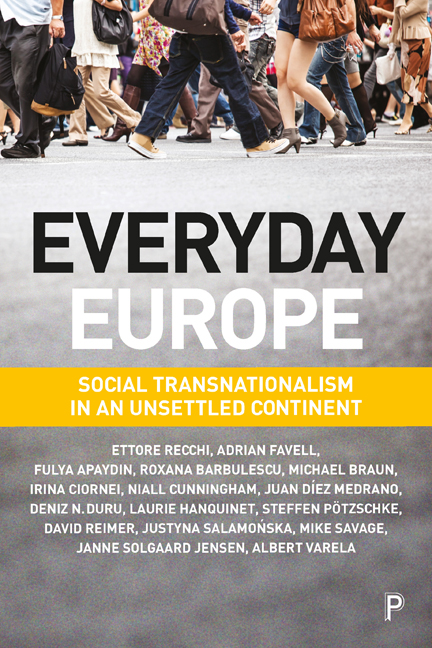Book contents
- Frontmatter
- Contents
- List of tables and figures
- Notes on contributors
- Acknowledgements
- Introduction: Social transnationalism in an unsettled continent
- one Cartographies of social transnationalism
- two The social structure of transnational practices
- three Cultural boundaries and transnational consumption patterns
- four Social transnationalism and supranational identifications
- five Explaining supranational solidarity
- six Narratives and varieties of everyday transnationalism
- seven Understanding Romanians’ cross-border mobility in Europe: movers, stayers and returnees
- eight Transnational Turkey: the everyday transnationalism and diversity of Turkish populations in Europe
- Epilogue Is social transnationalism fusing European societies into one?
- Methodological appendix
- Index
five - Explaining supranational solidarity
Published online by Cambridge University Press: 19 April 2022
- Frontmatter
- Contents
- List of tables and figures
- Notes on contributors
- Acknowledgements
- Introduction: Social transnationalism in an unsettled continent
- one Cartographies of social transnationalism
- two The social structure of transnational practices
- three Cultural boundaries and transnational consumption patterns
- four Social transnationalism and supranational identifications
- five Explaining supranational solidarity
- six Narratives and varieties of everyday transnationalism
- seven Understanding Romanians’ cross-border mobility in Europe: movers, stayers and returnees
- eight Transnational Turkey: the everyday transnationalism and diversity of Turkish populations in Europe
- Epilogue Is social transnationalism fusing European societies into one?
- Methodological appendix
- Index
Summary
Introduction
The 2008 financial crisis highlighted the European Union's enormous regional and national economic inequalities. It also revealed significant social distance between the citizens of different European Union member states and the persistence of national stereotypes. This prompted a shift from exclusive attention to European identification to a new focus on European solidarity. This chapter is motivated by that interest.
Pan-European solidarity guided integration efforts since the creation of the European Coal and Steel Community in 1951 (Sangiovanni 2013). More recently, the Treaty of Maastricht and the Lisbon Treaty situated solidarity as one of the European Union's central objectives. The latter, in particular, includes a solidarity clause (article 222), according to which ‘The Union and its Member States shall act jointly in a spirit of solidarity if a Member State is the object of a terrorist attack or the victim of a natural or man-made disaster’. The practical instantiation of this solidarity clause, the EU Solidarity Fund, is just one of several institutions, including the structural and cohesion funds, through which the European Union has pursued this objective over the years. Intergovernmental conflict and the mobilisation of nationalist sentiment that has followed the fiscal and debt crisis of several EU member states can in fact be traced to legal and policy debate on how to render these principles, institutions and policies compatible with the strict fiscal requirements of the monetary union's Stability Pact and article 125 of the Lisbon Treaty (the so-called no bailout clause) according to which:
The Union shall not be liable for or assume the commitments of central governments, regional, local or other public authorities, other bodies governed by public law, or public undertakings of any Member State, without prejudice to mutual financial guarantees for the joint execution of a specific project. A Member State shall not be liable for or assume the commitments of central governments, regional, local or other public authorities, other bodies governed by public law, or public undertakings of another Member State, without prejudice to mutual financial guarantees for the joint execution of a specific project.
- Type
- Chapter
- Information
- Everyday EuropeSocial Transnationalism in an Unsettled Continent, pp. 137 - 170Publisher: Bristol University PressPrint publication year: 2019



